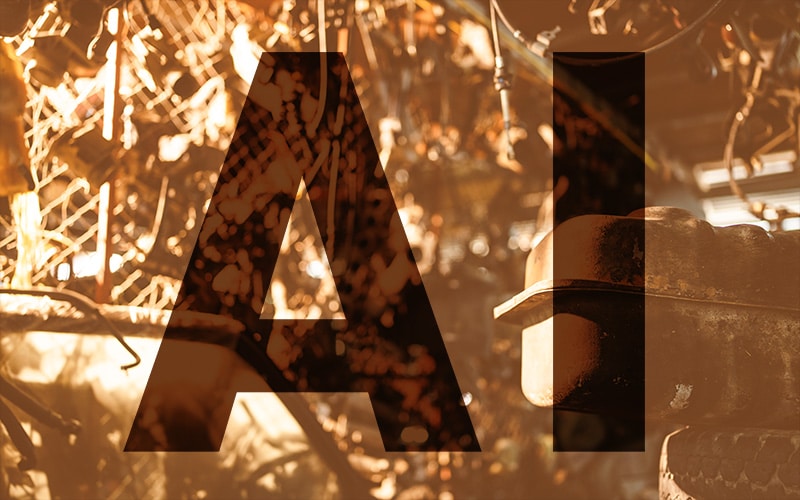As technology companies race to win the advantage in developing artificial intelligence, AI is promising to revolutionize every industry–including the recycling industry. Recyclers are looking for AI innovations to tackle some of the biggest challenges to increasing recycling rates, such as material contamination, worker shortages and rising costs.
How AI can rescue recycling
Waste generation is expected to increase 73 percent by the year 2050 according to a Forbes article last year, “Turning Trash into Treasure: How AI is Revolutionizing Waste Sorting.” According to the article, AI is emerging as a powerful tool to help sort waste, increase recycling rates and keep recyclables out of landfills. The key is to improve sorting.
At large recycling facilities today, waste moves down conveyor belts where traditionally workers would sort recyclable materials. The average worker can sort 50 to 80 pieces per minute, according to a Wall Street Journal report on AI, but the problem is the shrinking number of workers available to do the job. AI robots working in their place can reliably pick up more pieces per minute using arms and suction cups to sort through bottles and cartons and do it more safely than humans. Additionally, robots are less likely to incorrectly identify material which contaminates recyclables.
New automated sorting systems use robotics and machine learning to sort waste, while computer vision improves material identification. EverestLabs, a California-based company, is using a 3-D vision system to develop algorithms for recyclables sorting. Their platform, RecycleOS, can sort objects with 95 percent accuracy, according to the Forbes article, increasing speed and preventing contamination.
“AI-enabled recycling systems are expected to become standard in new recycling facilities by 2030,” according to Columbia University’s “State of the Planet” blog last month. These new systems using robotics with AI vision, cameras and infrared sensors have shown a 60 percent increase in efficiency and a 35 percent reduction in worker injuries, according to the article.
AI can also gather valuable data about what is in the waste stream. This ability could help address the increase in hard-to-recycle plastic waste which can be better identified and sorted with AI. The data collected could also be used to work with manufacturers. Armed with this information, recyclers could possibly get manufacturers to help recover recycling costs or improve packaging designs for greater material recovery. Finally, this valuable data can help address contamination in the waste stream.
Contamination in recycling streams has been a long-standing issue impeding recycling rates. Contaminants slow down the recycling process and increase operating costs. Common contaminants in recycling programs are plastic bags and things that tangle in machinery like light strands or hoses. According to the online newsletter Waste 360, AI and camera technology are now being used on trucks by companies picking up recyclables. The truck-mounted camera can photograph and video material being hauled. Artificial intelligence is then able to flag material considered a contaminant. In this way, recycling companies can identify the source of the contamination and address the problem with the entity responsible for the contamination. By addressing the contamination at its source, the hope is that over time it will be diminished, or the cost covered by the responsible party.
Truck-mounted cameras with AI systems can address other issues for recyclers as well. According to WasteVision AI, a company providing this technology, haulers also can see safety and efficiency benefits with these applications. The same camera system doing the AI monitoring can be used for driver assistance, telematics solutions, and to capture events or crashes for insurance purposes.
AI-driven advances in scrap metal recycling
These AI advances are making their way into the scrap metal recycling industry. Scrap metal recyclers have already employed technology to increase their efficiency. For decades, X-ray analyzers that can detect metals and alloys have been available to streamline sorting operations. The AMP Robotics website states that its technology can be used for metals such as aluminum, aerosol cans, nonferrous food containers and foil. One Finnish company, ZenRobotics, in 2014 unveiled a sorting system using AI and sensor technology. According to the company, its product can sort copper, brass, stainless steel, and aluminum, and is used in some European scrap metal recycling facilities.
Outlook for AI in recycling
According to industry reports, the forecast is bright for AI-driven technologies to improve and come down in price so their use can be more widespread and cost effective in the recycling industry. In North America, some 340 plants have been built or retrofitted to incorporate AI recycling systems, according to the State of the Planet blog. While the current price tag for an AI optical sorting system can be as high as $300,000, more companies are leasing the equipment to cut down on up-front costs. Industry experts predict that maintenance and upgrades of the equipment should decrease in the future as the technology improves, facilitating even more widespread use of AI-enabled recycling systems.
About ScrapWare Corporation: Since 1989, Rockville, Maryland-based ScrapWare Corporation has been the software of choice for the recycling industry. Its ease of installation and simplicity saves users time and money while helping them achieve compliance and maintain accurate business insights. With state-of-the-art functionality tailored to each organization’s unique requirements, ScrapWare is an advanced dynamic software solution that alleviates the most pressing recycling industry worries. For more information, please call (301) 517-8500 or visit https://www.scrapware.com/.

